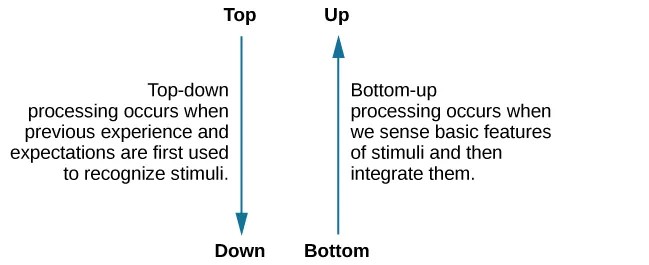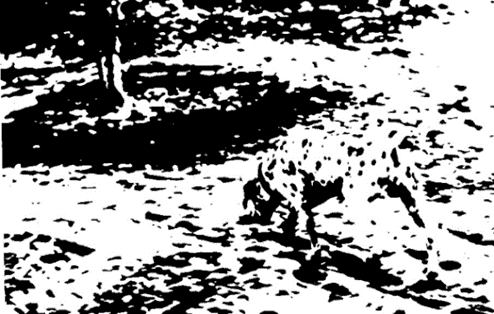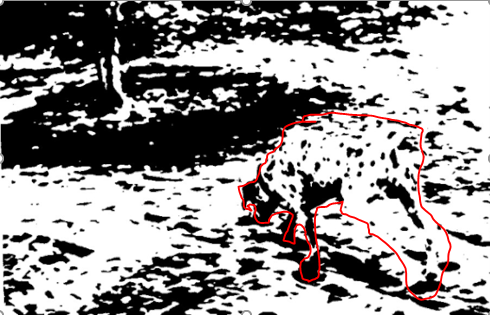2.2 Perception
Have you ever listened to two people in conflict tell their stories of what happened, and then asked yourself if the two parties were really talking about the same conflict because their stories were so inherently different from each other? Sensory perception and the various factors that shape and influence our perception is a great starting point to gain a better understanding of the differences in people’s conflict experiences. After all, many definitions and models of conflict consider people’s perceptions as main sources or components of conflict (consider, for example, Galtung’s [1969] ABC triangle).

The term perception as a cognition and as we use it in this chapter refers to our experiences that result from the stimulation of our senses and the process of meaning-making of these experiences (note that in Chapter 5, we will look at the phenomenon of “social perception”, which relates to how we perceive and make meaning of information about others in a social context). Our cognitive perception is evolving and changing based on the information presented to us. Often, we consider perception as an automatic process, but it is much more complex. Consider perception as the gateway to all other cognitions involving dynamic functions that support our actions. How would you perceive the world if you couldn’t see, touch, smell, taste or hear? It would be impossible.
As an introduction, to perception, please watch the following video until about 3:51 (after that, the video goes into the details of visual perception, which you don’t have to know about for this eBook): Perceiving is Believing: Crash Course Psychology #7.
In the video, Hank Green refers to perception as “the top-down way our brains organize and interpret information and put it into context” (we will look at the term “top-down” in more detail shortly). We have previously learned that every brain is unique, shaped by an interplay of the genetic makeup and the environment in which the brain developed. Therefore, the process of organising and interpreting information, as well as putting it into context, is heavily influenced by an individual’s nature, experiences, moods, social environments, and cultures. Acknowledging our own “lens” and biases in terms of how we perceive our world and give meaning to any incoming information is important to prepare ourselves to appreciate the different perceptions that parties frequently have when it comes to the experience of conflict.
To see how perceptions may influence the stories and experiences of people in conflict, please read the following reading:
Key Reading
Heen, S., & Stone, D. (2006). Perceptions and stories. In A. Kupfer Schneider & C. Honeyman (Eds.), The negotiator’s fieldbook: The desk reference for the experienced negotiator (pp. 343-350). American Bar Association.
It is important to note here, that our perceptions are frequently inaccurate and can be fooled. Have a look at this “optical illusion” video [2:06] to illustrate how our visual perception can be fooled:
As Hank Green noted in the Crash Course video “Perceiving is Believing”, “sometimes, what you see is not actually what you get”. Or, in the words of Feldman Barrett (2017a), “you see what your brain believes” (p. 78). Feldman Barrett discusses this phenomenon, which she refers to as “affective realism” in greater detail in her book, How emotions are made. Understanding that our beliefs drive our perception also helps us understand how our beliefs influence our emotions, which we will discuss in more detail in the next chapter.
Approaches to Explaining Perception
Different approaches have been developed to explain the process of perception. While we don’t need to know about these different approaches in detail, it is worth briefly considering at least the distinction between bottom-up and top-down processing (you will see these terms again when we discuss emotions in the next chapter).
Bottom-Up and Top-Down Processing
Bottom-up processing is frequently referred to as “data-driven”. This type of processing begins with our receptors, which take in sensory information and then send signals to our brain. Our brain processes these signals and constructs a perception based on the signals. When our perception depends on more than the stimulation of our receptors, we speak about top-down processing. During top-down processing, we interpret incoming information according to our prior experiences and knowledge. This process is frequently referred to as concept or schema-driven.

Look at the following image. What can you see in the image? Please spend a few moments trying to make sense of the black blobs.

If you have never seen this picture before, you are likely to continue seeing black blobs, even if you keep looking at it for longer. This is an example of sensory stimulation (bottom-up processing) being insufficient to correctly experience what is depicted in the picture. Once you know what is in the picture (it depicts a Dalmatian sniffing the ground in front of a tree) – or as Feldman Barrett (2017a) puts it “once you have been cured of your experimental blindness” (p. 26) – you will group some black blobs as the Dalmatian and others as shadows in the background (if you can’t see the Dalmatian, please scroll to the bottom of this page for some help). You can do this because “neurons in your visual cortex changed their firing to create lines that aren’t present, linking blobs into a shape that isn’t physically there” (Feldman Barrett, 2017a, p. 26). Your brain will “construct” this picture out of the blobs, based on your new knowledge of what the picture shows (top-down processing) and will most likely do this every time you see the picture again.
What can we learn from this activity? Hopefully, the photo of the Dalmatian experience will help you appreciate the importance of past experiences to give meaning to any present sensation. As an important side fact, Feldman Barret highlights that our interpretations and giving meaning to sensory perceptions as in the Dalmatian picture happen unconsciously: “The entire process of construction is invisible to you. No matter how hard you try, you cannot observe yourself or experience yourself constructing the image” (Feldman Barrett, 2017a, p. 26). She calls the process of constructing an image based on prior experience as “simulation”. What is well worth noting is that simulation can be visual but can also involve any other senses, e.g., when you have an “audio hallucination” and keep rehearsing a song in your head. Furthermore, simulation may not only be common for sensory perception but also for feeling empathy, understanding language, remembering, imagining, etc. Since all these processes are relevant to the experience of conflict, we encourage you to now give some thought to how the phenomenon of simulation may apply to conflict management.
The Gestalt Approach
Another approach to explaining perception is the Gestalt approach. While less relevant to the experience of conflict, we will consider aspects of this approach later in this chapter when we focus on decision-making. So you may want to check out the table below for some key principles of the Gestalt approach. The principle of “closure” may not only be true for the visual perception of objects but may also extend to how people tend to ignore missing or incomplete information about people and events to paint a smooth conflict narrative.
| Principle | Description | Example | Image |
| Figure-ground relationship
|
We structure input so that we always see a figure (image) against a ground (background). | At right, you may see a vase or you may see two faces, but in either case, you will organise the image as a figure against a ground. |  |
| Similarity | Stimuli that are similar to each other tend to be grouped together. | You are more likely to see three similar columns among the XYX characters at right than you are to see four rows. |  |
| Proximity | We tend to group nearby figures together. | Do you see four or eight images at right? Principles of proximity suggest that you might see only four. |  |
| Continuity | We tend to perceive stimuli in smooth, continuous ways rather than in more discontinuous ways. | At right, most people see a line of dots that moves from the lower left to the upper right, rather than a line that moves from the left and then suddenly turns down. The principle of continuity leads us to see most lines as following the smoothest possible path. |  |
| Closure | We tend to fill in gaps in an incomplete image to create a complete, whole object. | Closure leads us to see a single spherical object at right rather than a set of unrelated cones. |  |
Note: “Summary of Gestalt Principles of Form Perception” by J. A. Cummings & L. Sanders, Introduction to Psychology is licensed under CC BY-NC-SA
Perception
Extension:
If you want to learn more about the principles listed in the table above, you may wish to watch this video about Gestalt Principles.
The Depths of Perception: Bias, Prejudice, and Cultural Factors (adapted from Introduction to Psychology & Neuroscience)
Perception is a complex process. Built from sensations, but influenced by our own experiences, biases, prejudices, and cultures, perceptions can be very different from person to person. Research suggests that implicit racial prejudice and stereotypes affect perception. For instance, several studies have demonstrated that non-Black participants identify weapons faster and are more likely to identify non-weapons as weapons when the image of the weapon is paired with the image of a Black person (Payne, 2001; Payne, Shimizu, & Jacoby, 2005 cited in Stevens, L. & Stamp, J., 2020). Furthermore, White individuals’ decisions to shoot an armed target in a video game is made more quickly when the target is Black (Correll, Park, Judd, & Wittenbrink, 2002; Correll, Urland, & Ito, 2006 cited in Stevens, L. & Stamp, J., 2020). This research is important, considering the number of very high-profile cases in the last few decades in which young persons of colour were killed by people who claimed to believe that the unarmed individuals were armed and/or represented some threat to their personal safety.
Reflection Activity
Solution:

Chapter Attributions
Speilman, R. M., Jenkins, W.J., & Lovett, M. D. (2020). Psychology 2e. OpenStax is licensed under a Creative Commons Attribution 4.0 International License
Stevens, L & Stamp, J. (Eds.). (2020). Introduction to Psychology & Neuroscience, Dalhousie University Libraries Digital Edition, is licensed under a Creative Commons Attribution 4.0 International License

